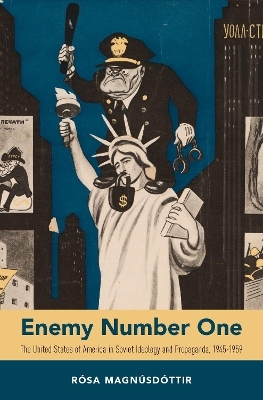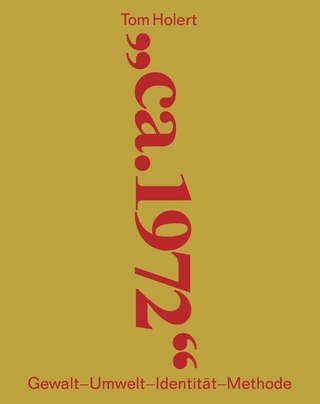
Enemy Number One
The United States of America in Soviet Ideology and Propaganda, 1945-1959
Seiten
2019
Oxford University Press Inc (Verlag)
978-0-19-068146-3 (ISBN)
Oxford University Press Inc (Verlag)
978-0-19-068146-3 (ISBN)
From Stalin's anti-American campaign to Khrushchev's peaceful coexistence policy, this book addresses the Soviet propaganda and ideology directed towards the United States during the early Cold War.
Enemy Number One tells the story of the Soviet cultural and propaganda apparatus and its efforts to control information about the United States in the postwar landscape. Beginning with the 1945 meeting of American and Soviet troops on the Elbe, this period saw cultural relations develop in close connection to oppression as the Soviet authorities attempted to contain and appropriate images of the United States. Rósa Magnúsdóttir analyzes two official narratives about the USSR's "enemy number one" --Stalin's anti-American campaign and Khrushchev's policy of peaceful coexistence--and shows how each relied on the legacy of the wartime alliance in their approach. Stalin used the wartime experience to spread fear of a renewed war, while Khrushchev used the wartime alliance as proof that the two superpowers could work together.
Drawing from extensive archival resources, Magnúsdóttir brings to life the propaganda warriors and ideological chiefs of the early Cold War period in the Soviet Union, revealing their confusion and insecurities as they attempted to navigate the uncertain world of late Stalin and early Khrushchev cultural bureaucracy. She also demonstrates how concerned Soviet authorities were by their people's presumed interest in the United States, resorting to monitoring and even repression-behavior indicative of the inferiority complex of the Soviet project as it related to the outside world.
Enemy Number One tells the story of the Soviet cultural and propaganda apparatus and its efforts to control information about the United States in the postwar landscape. Beginning with the 1945 meeting of American and Soviet troops on the Elbe, this period saw cultural relations develop in close connection to oppression as the Soviet authorities attempted to contain and appropriate images of the United States. Rósa Magnúsdóttir analyzes two official narratives about the USSR's "enemy number one" --Stalin's anti-American campaign and Khrushchev's policy of peaceful coexistence--and shows how each relied on the legacy of the wartime alliance in their approach. Stalin used the wartime experience to spread fear of a renewed war, while Khrushchev used the wartime alliance as proof that the two superpowers could work together.
Drawing from extensive archival resources, Magnúsdóttir brings to life the propaganda warriors and ideological chiefs of the early Cold War period in the Soviet Union, revealing their confusion and insecurities as they attempted to navigate the uncertain world of late Stalin and early Khrushchev cultural bureaucracy. She also demonstrates how concerned Soviet authorities were by their people's presumed interest in the United States, resorting to monitoring and even repression-behavior indicative of the inferiority complex of the Soviet project as it related to the outside world.
Rósa Magnúsdóttir is Associate Professor of History at Aarhus University. She received her PhD in history from the University of North Carolina at Chapel Hill.
Acknowledgments
Note on Transliteration and Translation
Introduction
Part I. Stalin's Script for Anti-Americanism
1. The Anti-American Campaign, 1945-1953
2. American Sources of Information and Soviet Interest in the Enemy
3. Soviet-American Cultural Encounters in Late Stalinism
Part II. Khrushchev and the Discourse of Peaceful Coexistence
4. From Anti-Americanism to Peaceful Coexistence
5. The Paradoxes of Peaceful Coexistence, 1956-1957
6. The Possibilities of Peaceful Coexistence, 1958-1959
Epilogue
Glossary
Notes
Bibliography
Index
| Erscheinungsdatum | 16.12.2018 |
|---|---|
| Zusatzinfo | 6 halftones |
| Verlagsort | New York |
| Sprache | englisch |
| Maße | 236 x 157 mm |
| Gewicht | 499 g |
| Themenwelt | Geisteswissenschaften ► Archäologie |
| Geschichte ► Allgemeine Geschichte ► Zeitgeschichte | |
| Geisteswissenschaften ► Geschichte ► Regional- / Ländergeschichte | |
| Geschichte ► Teilgebiete der Geschichte ► Kulturgeschichte | |
| ISBN-10 | 0-19-068146-2 / 0190681462 |
| ISBN-13 | 978-0-19-068146-3 / 9780190681463 |
| Zustand | Neuware |
| Haben Sie eine Frage zum Produkt? |
Mehr entdecken
aus dem Bereich
aus dem Bereich
Gewalt, Umwelt, Identität, Methode
Buch | Softcover (2024)
Spector Books OHG (Verlag)
36,00 €
wie Freud im Kollektiv verschwand
Buch | Hardcover (2024)
Klett-Cotta (Verlag)
25,00 €


